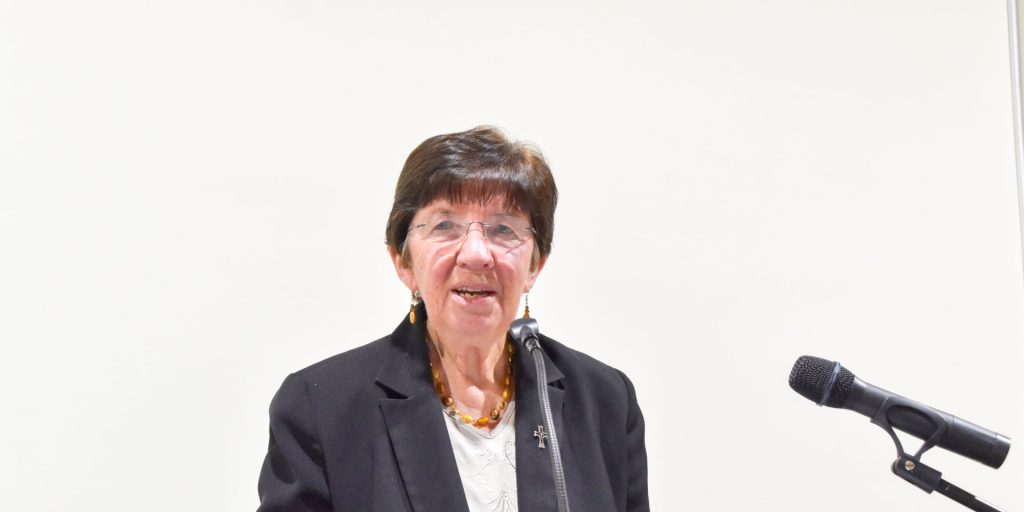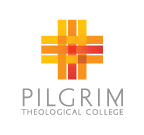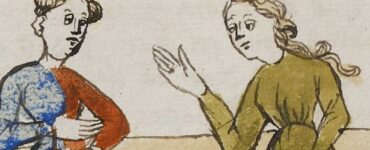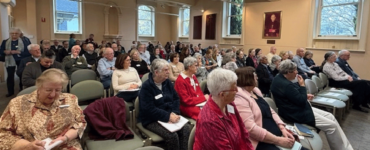
The first annual Janette Gray Lecture, given by Emeritus Professor Elaine Wainwright RSM, 31 August 2018
- Now when Jesus had finished these sayings, he went away from Galilee and entered the region of Judea beyond the Jordan. 2 And large crowds followed him, and he healed them there (Matt 19:1-2) (and he spoke with them at length weaving a tapestry of woven threads).
- And when Jan had finished all her sayings, she went away from here and entered the realm beyond death. And crowds have gathered here to honour her and in this gathering, we shall be touched and shall be healed a little more of the deep loss of a colleague and friend as we attend to her tapestry of woven threads.
What an extraordinary privilege it is to have been invited to present this Inaugural Lecture in honour of Dr Janette Gray, known familiarly to us as Jan. In preparing for it I have been drawn much more deeply into Jan’s life and work. Tonight I hope to lay out before you something of the woven tapestry of her theologizing through the lens of a biblical text: Matthew 19 whose opening verses I have just cited. In sharing my title and text with a colleague at an initial stage of preparing for this lecture, she expressed surprise at my choice. I was guided, however, by the focus of Matt 19 on relationships following as it does Matt 18 which some call the Community Discourse. It is my hope that dialogue with this biblical text will provide me with a framework for the broader dialogue with Jan’s theology or theological undertakings and that we might experience something of the tapestry of woven threads that link her life and work to the biblical text and into our lives.
My usual way of beginning an interpretation of a biblical text is to set out the hermeneutical lens that I bring to that task. Given the urgency of the current ecological crisis that faces our planet, the perspective which informs my reading of the biblical text is ecological and my way of reading I call eco-rhetorical. My hermeneutical lens and my methodological approach coalesce as I seek to attend carefully to the narrative features of the text and the way these both hide and reveal ecological insights. In this lecture, I bring these not only to the biblical text but to all texts with which I engage, especially, in this lecture, Jan’s two theses, her Masters and her doctorate.
Neither Escaping nor Exploiting Sex
The final chapter of Jan’s Masters thesis, published as Neither Escaping nor Exploiting Sex: Women’s Celibacy is entitled “Ecology of Celibacy”.[1] Ecology was not an explicit interpretive lens informing her unfolding work but it functioned then for readers on reaching her final chapter as a lens that she directs backward over the material covered and forward into new interpretations of women’s commitment to celibacy. In this her work was and still is very innovative.
Initially, her ecological hermeneutic leads her to uncover and emphasize the function of ‘death’ within the choice and life of celibacy, recognizing that it “is not in opposition to other lives but performs a different function in the web of life.”[2] Death, is, however more pervasive and pernicious. Of this Jan says that “(h)umanity’s capacity for death-dealing not only threatens itself, the planet and the cosmos; it also signals a death of God. It disclaims any cosmic purpose in life beyond what is already nearly destroyed.”[3] In the face of such ultimate destruction, Jan concludes that celibacy “requires a clearer identification of its meaning in relation to life as well as death.”[4]
She provides this by turning to figures such as Teilhard de Chardin and Thomas Berry. Berry, she claims regards “the ultimate task of humanity” to be “conversion from an instrumental and utilitarian concern about what physically supports us to a total involvement with the world of life.”[5] This, she suggests, should enable the experience of celibacy to be understood more ecologically.
Such an ecological view of celibacy is not a new thing, Jan reminds us. Hildegard of Bingen, Francis of Assisi, Gerard Manley Hopkins, and Teilhard de Chardin, for example, all demonstrated “profound ecological awareness” which informed their reflections on their celibate lives.[6] We are now in a new place and a new time with new challenges which Jan lays out:
Lack of generativity has a social and cosmic purpose yet to be communicated more clearly by women celibates. Their private option could develop in them an awareness of a cosmic concern active beyond the self. It could expand the celibate responsibility beyond narrow immediate concerns like one’s person, place, and the present, to include the communal, cosmic, and the future.[7]
Indeed, we have barely begun such expansion of celibate responsibility in an ecological age and so Jan’s work goes with us into the future as a profound challenge.
This turns us now, with a more developed ecological reading lens, to the Matthean text and the short verse, Matt 19:12 which belongs in the context of Jesus’ teaching on divorce (19:3-8) and the subsequent discussion with the disciples (19:9-12) on divorce, remarriage and chastity.
After the teaching on divorce and re-marriage, the text goes on:
10 His (Jesus’) disciples said to him, “If such is the case of a man with his wife, it is better not to marry.” 11 But he said to them, “Not everyone can accept this teaching, but only those to whom it is given. 12 For there are eunuchs who have been so from birth, and there are eunuchs who have been made eunuchs by others, and there are eunuchs who have made themselves eunuchs for the sake of the kin(g)dom of heaven. Let anyone accept this who can.”
I do not want, in this lecture, to enter into the complex discussions that emerge from 19:3-11 and the topic of divorce and remarriage.[8] Suffice it to recognize in these verses an early Christian community grappling with the complexity of human relationships, especially as these find expression in marriage and divorce.
I do, however, want to turn attention to Matt 9:12, in light of Jan’s focus on celibacy. V. 12 is a complex text within a broader context focused on the structuring of human relationships. It is in sharp contrast to Jan’s work on women’s celibacy as this entire section (vv. 3 – 12) encodes male experience (and male experience only) and a world-construction of masculinity, both affirming it while also interrogating and subverting it. Indeed, Janice Capel Anderson and Stephen Moore, two excellent New Testament scholars whose work on Matthean masculinity has been most comprehensive, claim that Matt 9:12 has Jesus proferring a
countercultural vision of a physically impotent but spiritually potent masculinity that engenders not literal children, but spiritual children, spiritual fruit. This vision is couched in the threatening yet fascinating figure of the eunuch, who is poised precariously on the sliding scale between man and unman…the eunuch leads a boundary-blurring, altogether subversive existence.”[9]
Can we hear in these closing words of Anderson and Moore (“the eunuch leads a boundary-blurring, altogether subversive existence”) similar echoes to those of Jan cited earlier in relation to contemporary women’s celibacy understood ecologically: “(l)ack of generativity has a social and cosmic purpose.” The Matthean vision of the eunuch for the sake of the basileia or kin(g)dom can be read in light of the communal, the cosmic, and the future, the challenge Jan’s exploration of woman’s choice of celibacy holds out to us in this ecological age.
Jan introduces us to Marie-Dominique Chenu
I want to cross over now to Jan’s more recent work, namely her PhD research which focused on the great French theologian, Marie-Dominique Chenu,[10] and to begin where she begins, namely with the bridge, Pont-Saint-Esprit which Chenu experienced as a “material preaching of the gospel”. Let me introduce you briefly to this Pont-Saint-Esprit as it had meaning for Chenu.[11]
The bridge was constructed by a confraternity of urban traders in the twelfth century as feudalism was coming to an end across Europe. It was built to give access to the thriving markets in the town, across the river from the feudal landholdings. It assisted, therefore, in the emergence of a new social fabric. Chenu saw the bridge as “bringing people together for commercial and social interests, as much as for the sacred meetings of pilgrimage and feast days.” In this way, for Chenu, the “Trinity (w)as revealed in the mission of the Holy Spirit.” He saw the “sacred emerge from the profane,”[12] a thread which weaves its way across his work and hence, Jan’s thesis.
Jan says of this focus:
Chenu’s account of the bridge illustrates the dynamic of faith as relational and historically conditioned. It also represents the theological possibility of materiality, as embodied in the transformation of relations brought about by the construction of the bridge, a material artefact of the Holy Spirit’s communion. Indeed, this bridge and the way in which Chenu analysed and applied its doctrinal implications summarise the scope, method and major concerns of his theology. His theology spanned the theological and socio-political turbulence of the twentieth century, from the Thomist revival at the opening of the century to the new anthropological dilemmas and social injustices raised by mass industrialisation, totalitarianism and war.”[13]
Chenu’s theological focus and informing principle was the incarnation. For him, it was in ‘les milieux sociaux’/social situations that the gospel was encountered, was incarnated and preached. And the JOCist movement with which Chenu was very engaged was profoundly informed by this shift in theological emphasis. Jan drew her readers’ attention to this extraordinary shift through naming its key characteristics as four in number:
- a constant re-awakening to the Gospel,
- giving primacy to the Word of God,
- understanding the Church as mission, and
- recognising the poor’s privileged reception of the Word of God.
“All of these, she said, “marked out an anthropological shift”. She concludes her study with a reiteration of this shift, naming Chenu’s work as “Christian anthropology” which is constituted by “(m)atter and history.”[14]
This returns us, for the moment, to the “matter” of the gospel and the conversation between Jesus and an unnamed one who asks of him: what must I do to have eternal life? (Matt 19:16). Anne Elvey has drawn attention to what she calls the “matter of the text” in the title of her 2011 publication, The Matter of the Text: Material Engagements between Luke and the Five Senses as a key element in reading ecologically.[15] The biblical text manifests itself to us in a range of media: it is on our screens, within the covers of a book, mediated to us materially. The text also encodes materiality and hence I evoke ‘habitat’ as both “materially and socially constituting the text” [16]and thus a key analytic category together with the ‘human’ and the ‘holy’ in reading ecologically, as Anne evokes matter to guide an ecological reading of the biblical text.
To demonstrate a contemporary ecological reading of the biblical text, I turn to Matt 19:16-22:
Matt. 19:16 Then someone came to him and said, “Teacher, what good deed must I do to have eternal life?” 17 And he said to him, “Why do you ask me about what is good? There is only one who is good. If you wish to enter into life, keep the commandments.” 18 He said to him, “Which ones?” And Jesus said, “You shall not murder; You shall not commit adultery; You shall not steal; You shall not bear false witness; 19 Honor your father and mother; also, You shall love your neighbor as yourself.” 20 The young man said to him, “I have kept all these; what do I still lack?” 21 Jesus said to him, “If you wish to be perfect, go, sell your possessions, and give the money to the poor, and you will have treasure in heaven; then come, follow me.” 22 When the young man heard this word, he went away grieving, for he had many possessions.
Matt 19:16-22 opens with a human encounter, the matter of bodies—a certain unidentified person who is by the second verse identified as male comes up to Jesus. The text is silent in 19:16 in relation to the material context of this encounter. The reader must remember back to 19:1 which recounts Jesus leaving Galilee and going to the region of Judea beyond the Jordan – indeed, he is beginning his journey to Jerusalem. The questions as to who will accompany Jesus, who will remain faithful to the end hover around this section of the gospel. Such a context also gives an urgency to the question: Teacher, what good deed must I do to have eternal life? This is a question rising up from the human community.
As we attend to Jesus’ reply to his questioner, we find that it is possible to hear ecological or other-than-human encodings in the text. We are very familiar with the right relationships within the human community that the text calls for in the commandments articulated: no murder, adultery or stealing by way of example. Each is concerned with relationships within the human community. A re-reading through an ecological lens will, however, alert the reader to the interrelationships of the human and the other-than-human elements that constitute the ecological texture of this text. Murder and adultery, for instance, break down right relationships in the human community and they dis-order material bodies. This dis-order is particularly evident in the command not to steal—the other-than-human, material property, is encoded into this text and requires attention.
Jesus’ questioner claims in v. 21 that he is in right relationship with others. It is only in bringing an ecological hermeneutic to the text, however, that the reader will hear, in the words of Jesus, that what the questioner lacks is right relationships between the human and other-than-human communities, characterized by Jesus as selling his material possessions, giving to the poor and following Jesus on the road to Jerusalem.
With such a reading before us, a reading I am calling ecological, engaging as it does the materiality of the human and other-than-human, I turn again to Chenu, I want to draw attention to the emphases that his Christian anthropology brought to the twentieth century as Jan has uncovered it. First, was his insistence that theology must be responsive to contemporary questions and in this regard, he emphasized the materiality in and through which these find expression. And while he did not share the ecological awareness that attends to such materiality today, we can make the step over into such attending. He also offers us a tool that can assist such theologizing, namely présence. Jan says that Chenu used the concept of ‘présence’ to describe the engagement of a theologian’s reflection with contemporary social and political life.
Another emphasis which enhances Chenu’s Christian anthropology is his focus on incarnation. Jan notes his emphasis on “human participation in the continuing becoming of the Incarnation as a progress towards human divinization” and cites his own words: Voici maintenant le fait chrétien. Dieu s’est fait homme, et, à partir de cette in-carnation, l’homme vit divinement. (3.12)—this now is the Christian faith: God became human and through this incarnation the human person lives divinely. Chenu extends his incarnational emphasis saying that: Il n’est pas possible de faire une théologie de l’homme sans une théologie de la nature, comme il est impossible de séparer une théologie du Verbe incarné d’une théologie du Verbe créateur (Just as a theology of the human person is inseparable from a theology of nature, so too is a theology of the Incarnate Word inseparable from a theology of the Word as Creator). We can hear now from our standpoint and our shifting ecological awareness that one can step over into such awareness from Chenu’s theology. Indeed, he himself may have taken that step as these words suggest:
L’homme récapitule en lui le cosmos. Il est à la jonction de la matière et de l’esprit. Il est le pivot par lequel toute la matière est récapitulée en lui; il humanise la matière, et c’est par là qu’elle est divinisée. (The human person encapsulates the cosmos in him or herself. The human is located at the intersection between the material and the spiritual. The human person is the pivotal point that gathers up and humanizes the material (or materiality). This is the process whereby humanity is divinized).
It is not surprising that Jan concludes that “(m)atter and history thereby constitute the framework for Chenu’s Christian anthropology.” Indeed a tapestry of extraordinary threads have been woven together as we’ve engaged with Jan’s engagement with the vast contribution that Chenu has made to theology’s developments in the twentieth century. We can hear echoes of that contribution in our own disciplines. Even though I did not know of the work of Chenu, my engagement with justice movements, new contextual biblical methodologies and theological reflection processes were and are coloured by the emphases that he brought to twentieth century theology and that is available to us now through Jan’s excellent study.
An Eco-Feminist Reading of Selected Texts:
Attentive to the echoes and emphases that have emerged from this engagement with the theological thematics of Marie-Dominique Chenu, I propose in this final section to read a short selection of the remaining verses of Matt 19 from a contemporary eco-feminist perspective in order that we might hear some of the developments that have occurred in biblical/theological studies from the seeds planted by Chenu and others who shared a similar vision. My hope is that these readings will contribute further to the ‘tapestry of woven threads’ that have constituted this lecture.
As already noted, the eco-feminist reading lens or hermeneutic that I bring to my reading of biblical texts is one which is grounded in ‘matter’ and grounded in ‘ history’. It begins with a recognition that the oppression of women and the oppression of earth are intimately connected and that they are woven into our contemporary context as well as into the biblical text. It is necessary, therefore to bring a critical lens, and in this instance an eco-feminist lens to our reading of text, context and biblical text. The biblical text to which I turn attention here is Matt 19: 13-15:
Then little children were being brought to him in order that he might lay his hands on them and pray. The disciples spoke sternly to those who brought them; 14 but Jesus said, “Let the little children come to me, and do not stop them; for it is to such as these that the kingdom of heaven belongs.” 15 And he laid his hands on them and went on his way.
The world constructed by Matt 19 to this point is an adult world/a male adult world of crowds and disciples and Jesus. Into this world someone brings ‘little children’ that Jesus might lay his hands on them. In the world encoded in this text, children were dependent on their father, the pater familias, and were without independent status. They owed obedience and even submission to their father.[17] It may have been this recognition of a lack of status that is encoded in the disciples’ stern reaction to their presence.
Jesus presents an alternative to this socio-cultural perspective on children. He instructs his disciples to “let the little children come to me.” (v. 14). He then makes an extraordinary claim: to such belong the kin(g)dom of the heavens. In the Matthean narrative, this kin(g)dom of the heavens is the heart of what is preached first by John the Baptist (Matt 3:2) and then by Jesus (4:17). It is a transformative vision, an alternative to the basileia of Rome. We can envisage it in the human realm and we tend to make this our focus. But the Roman basileia extended into and included the material world: animals, soils, land and water. I say of this basileia of the heavens in my eco-rhetorical reading of Matthew’s gospel that it is:
unique in the New Testament and also intertextually. It brings together the material and spatial term, the ouranōn/the heavens or sky with hē basileia–the socio-political designator evoking power or empire … This alternative of a basileia of ‘the heaven/heavens or sky’ could function as a critique of the empire of Rome in first century emerging Christian Judaism. There is a danger, however, which has been borne out in history, that when Christianity becomes the empire then the language of empire/basileia no longer functions prophetically but supports Christian imperialism.
This phrase is the kernel of the preaching of both John and Jesus (3:2; 4:17 and throughout the Matthean gospel) as is evident in the text we are considering, namely 19:14.[18] It offers an alternative to the basileia of Rome to the Matthean community and for contemporary readers, a gospel vision that engages not only the human but the other-than-human.
There is more that we could explore in Matt 19. Suffice here to acknowledge that the remaining verses that follow on from Jesus’ encounter with the unnamed one who seeks to know how best to live in right relationship in order to gain eternal life are concerned with this same question. They couch it in terms of who can be saved (19:25). Jesus’ vision is much more expansive. In v. 28 he points his listeners to the renewal of all things, to the paligginessia, the new genesis, we might say. Reading this hope/this promise through ecological lenses invites us to return in conclusion to Chenu and his emphasis on matter and history as the cornerstones of his anthropology.
In Conclusion
As I draw this lecture to a close, I want to leave the last word to Jan and through her to Chenu. Jan says that “Chenu saw the rediscovery of the human value of matter as the specific theological and sociological contribution of twentieth century modernity.[19] He further claimed for the twentieth century the vocation of pursuing a fuller understanding of the implications of the Incarnation…. Matter and history thereby constitute the framework for Chenu’s Christian anthropology.” A profound contribution in an ecological age.
[1] Janette Gray, Neither Escaping nor Exploiting Sex: Women’s Celibacy (Homebush: St. Paul’s, 1995), 125-157.
[2] Gray, Neither, 128.
[3] Gray, Neither, 130.
[4] Gray, Neither, 132.
[5] Gray, Neither, 140.
[6] Gray, Neither, 149.
[7] Gray, Neither, 151.
[8] For two examples of such discussions, see Craig A. Evans, Matthew (New Cambridge Bible Commentary; Cambridge: Cambridge University Press, 2012), 339-342; and Warren Carter, Matthew and the Margins: A Sociopolitical and Religious Reading (Maryknoll: Orbis, 2000), 378-382.
[9] Janice Capel Anderson and Stephen D. Moore, “Matthew and Masculinity,” in New Testament Masculinities, edited by Stephen D. Moore and Janice Capel Anderson. Semeia Studies 45 (Atlanta: Society of Biblical Literature, 2003), 68.
[10] Janette Gray, The Christian Anthropology of M.-D. Chenu. Doctor of Philosophy, Cambridge University. Pagination in the copy of the thesis available to me was not continuous but numbering began anew with each chapter.
[11] Gray, Christian Anthropology, Introduction, 1-5.
[12] Gray, Christian Anthropology, Introduction, 3.
[13] Gray, Christian Anthropology, Introduction, 4.
[14] Gray, Christian Anthropology, 7.25.
[15] Anne F. Elvey, The Matter of the Text: Material Engagements between Luke and the Five Senses. The Bible in the Modern World, 37 (Sheffield: Sheffield Phoenix, 2011).
[16] Elaine M. Wainwright, Habitat, Human, and Holy: An Eco-Rhetorical Reading of the Gospel of Matthew (The Earth Bible Commentary Series 6; Sheffield: Sheffield Phoenix Press, 2016), 21.
[17] See Warren Carter, Households and Discipleship: A Study of Matthew 19-20 (Sheffield: Sheffield Academic Press 1997).
[18] Wainwright, Habitat, Human, and Holy, 57-58.
[19] ‘Réflexions chrétiennes sur la vérité de la matière’ (1948) in La Parole de Dieu II. L’Évangile dans le temps (Paris: Cerf, 1964), pp. 447-451, (p. 448-9).

Pilgrim Theological College is a college of the University of Divinity from the Uniting Church tradition, based in Melbourne, Victoria.







Add comment